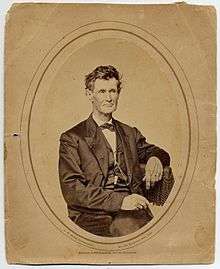M. F. Stephenson
| Dr. M. F. Stephenson | |
|---|---|
 Stephenson pictured between 1857 and 1860 | |
| Born |
Matthew Fleming Stephenson 1802 Virginia, U.S. |
| Died | 1881 (aged 78–79) |
| Resting place | Alta Vista Cemetery, Gainesville, Georgia, U.S. |
| Occupation | Assayer |
| Employer | Dahlonega Mint |
| Known for | Geology |
| Notable work | Geology and Mineralogy of Georgia |
| Spouse(s) | Sarah Lyon Stephenson (married 1836) |
| Children | 2 |
| Signature | |
|
| |
Dr. Matthew Fleming "M. F." Stephenson (1802–1882) was born in Virginia. On February 25, 1836, he married Sarah Elizabeth Sumter Lyon. He was considered a Georgia geology and mineral expert, although there is no record of him receiving any formal education in the field of geology. He was one of the first collectors of lazulite, rutile, pyrophyllite, and other minerals.
Stephenson wrote various articles on his observations of minerals, as well as mound excavations in Georgia. In the 1870s, several of his articles were published by the Smithsonian Institution, including Account of Ancient Mounds in Georgia and Mounds in Bartow County near Cartersville, Georgia. These described sites he visited and the artifacts found at each, such as mica mirrors, copper vessels, and quartz. He also published a major treatise in 1871 called Geology and Mineralogy of Georgia for which he is most famous.[1] Other published works include a pamphlet Diamonds and Precious Stones in Georgia in 1878 and a historical sketch in 1866, Report on the Lewis Mine Property, White County, Georgia.
He served as the assayer of the Dahlonega Mint in Dahlonega, Georgia in the 1840s. When the gold rush in Georgia was believed to be over, many miners headed west to join the 1849 California Gold Rush. Stephenson thought differently and in the town square proclaimed to over 200 men, “Why go to California? In that ridge lies more gold than man ever dreamt of. There’s millions in it.” This excerpt was retold to Mark Twain by the miners who moved to California from Georgia and may have inspired his character Mulberry Sellers. Sellers was famous for his lines “There’s gold in them thar hills” and “there’s millions in it.”[2][3][4]
See also
References
- ↑ Matthew F. Stephenson (1871). Geology and Mineralogy of Georgia: With a Particular Description of Her Rich Diamond District; the Process of Washing for Diamonds, Their Price and Mode of Cutting and Setting; Her Gold, Silver, Copper, Lead, Iron, Manganese, Graphite, Kaolin, Coal, Fire-clay, Mica, Corundum, Slate, Marble, &c. Globe Pub. Company. pp. 1–.
- ↑ Williams, David (2003-01-21). "Gold Rush". The New Georgia Encyclopedia. Georgia Humanities Council.
- ↑ Johnson, Edward A. ""Thar's Gold in Them Thar Hills" Georgia Gold History". "Thar's Gold in Them Thar Hills": Gold and Gold Mining in Georgia, 1830s-1940s. Digital Library of Georgia.
- ↑ Paris, Travis A. (Winter 2003–2004). "Dr. Matthew Fleming Stephenson: Pioneering Georgia Miner, Geologist, and Mineralogist". MATRIX: A Journal of the History of Minerals. 11.
External links
- Gainesville Times column on M.F Stephenson.
- M. F. Stephenson at Find a Grave
- Digital Library of Georgia project named after a famous misquotation of M.F Stephenson.